Modern Workplace Report: Leadership, Motivation, and Team Behaviour
VerifiedAdded on 2023/01/19
|12
|1620
|92
Report
AI Summary
This report provides an overview of the modern workplace, using Kellogg's as a case study. It covers various aspects, including the company's goals and objectives, leadership and management behaviours, group and team dynamics, and motivation theories. The report explores leadership styles such as situational leadership, and management approaches like scientific management. It also delves into group behaviour, differentiating between formal and informal groups, and highlights the importance of motivation, particularly Maslow's theory, in driving employee performance. The report concludes by emphasizing the significance of leadership and management in fostering a productive and positive work environment within the company. The report uses various references to support its findings.
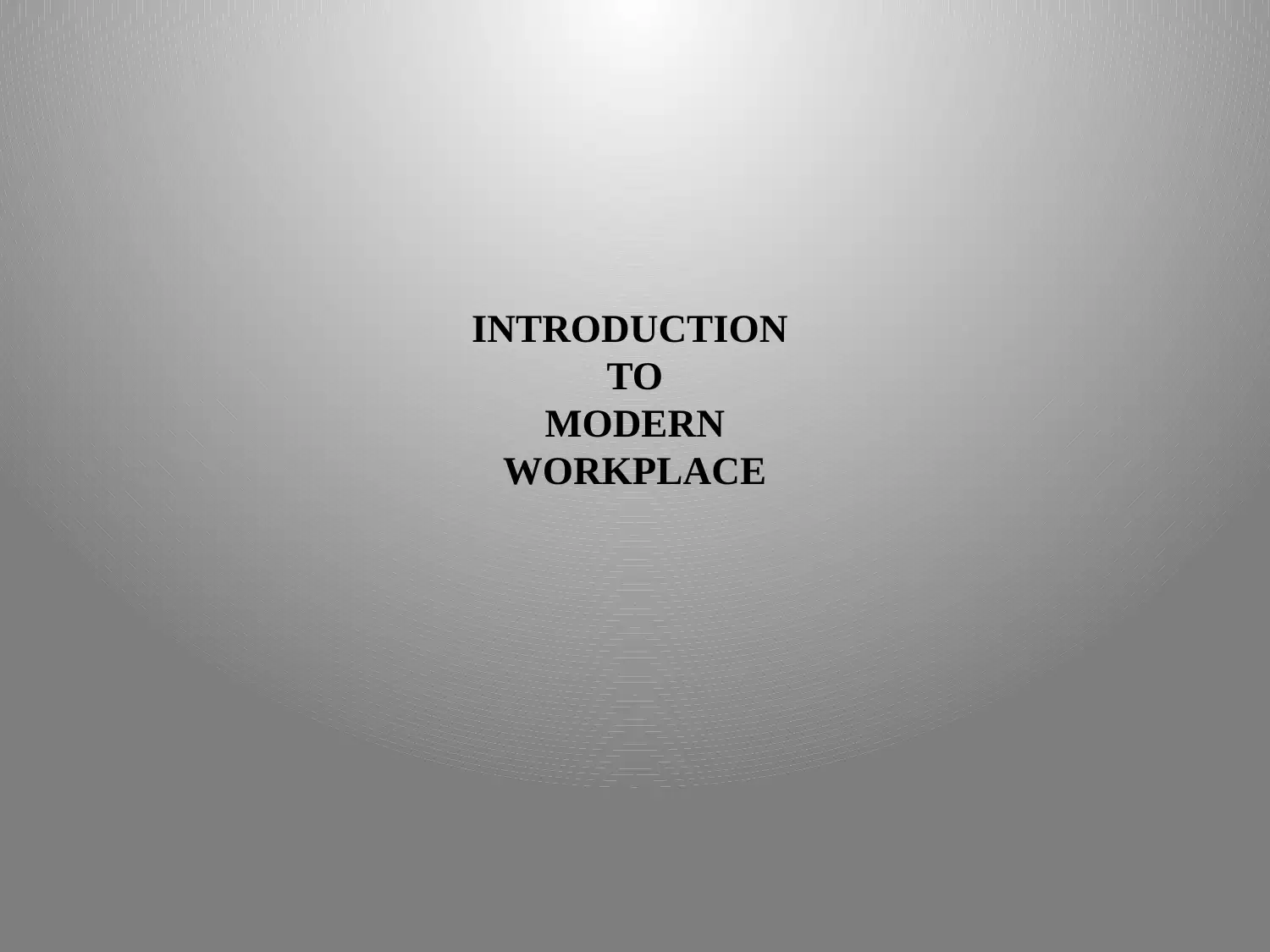
INTRODUCTION
TO
MODERN
WORKPLACE
TO
MODERN
WORKPLACE
Paraphrase This Document
Need a fresh take? Get an instant paraphrase of this document with our AI Paraphraser
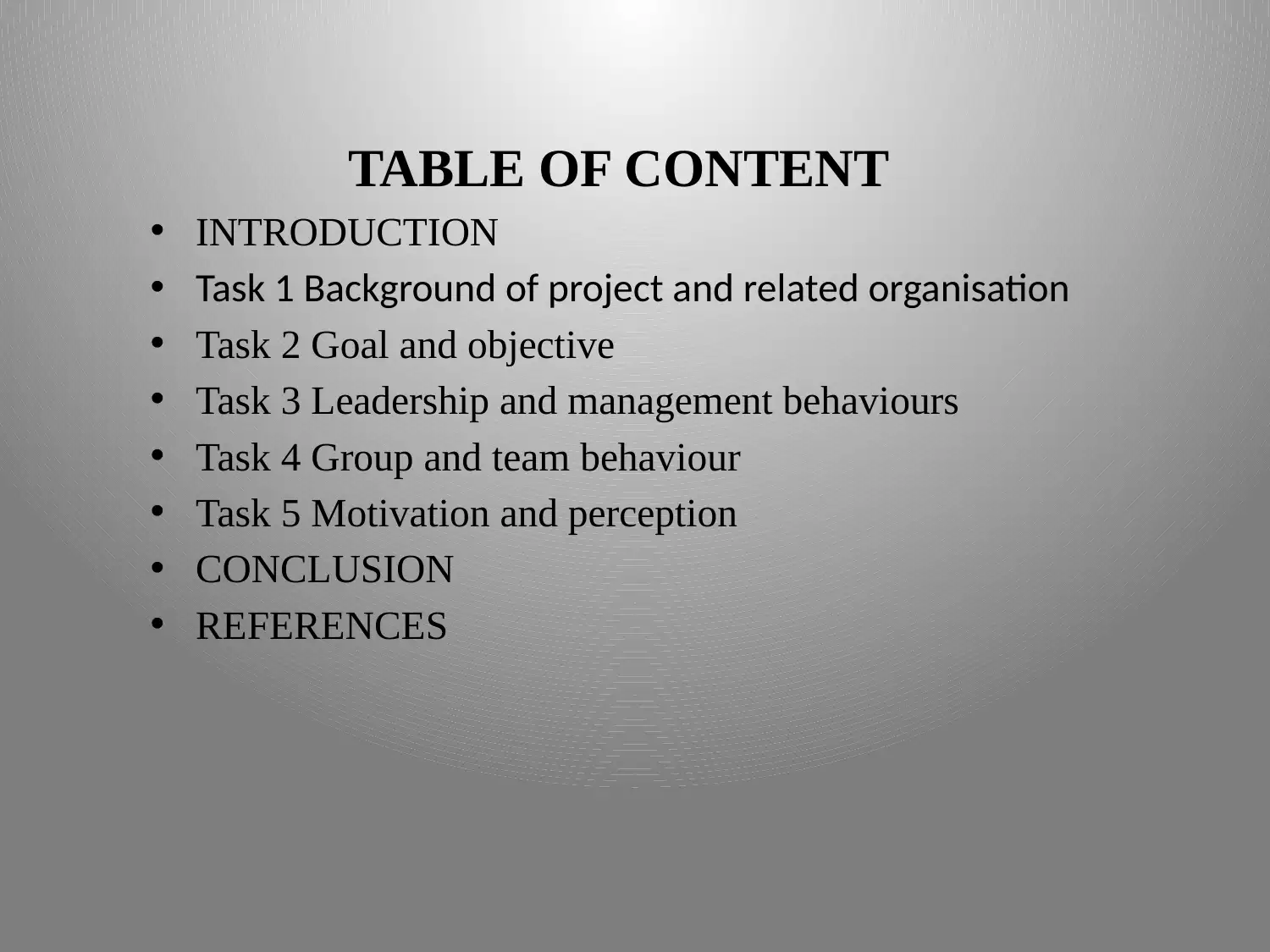
TABLE OF CONTENT
• INTRODUCTION
• Task 1 Background of project and related organisation
• Task 2 Goal and objective
• Task 3 Leadership and management behaviours
• Task 4 Group and team behaviour
• Task 5 Motivation and perception
• CONCLUSION
• REFERENCES
• INTRODUCTION
• Task 1 Background of project and related organisation
• Task 2 Goal and objective
• Task 3 Leadership and management behaviours
• Task 4 Group and team behaviour
• Task 5 Motivation and perception
• CONCLUSION
• REFERENCES
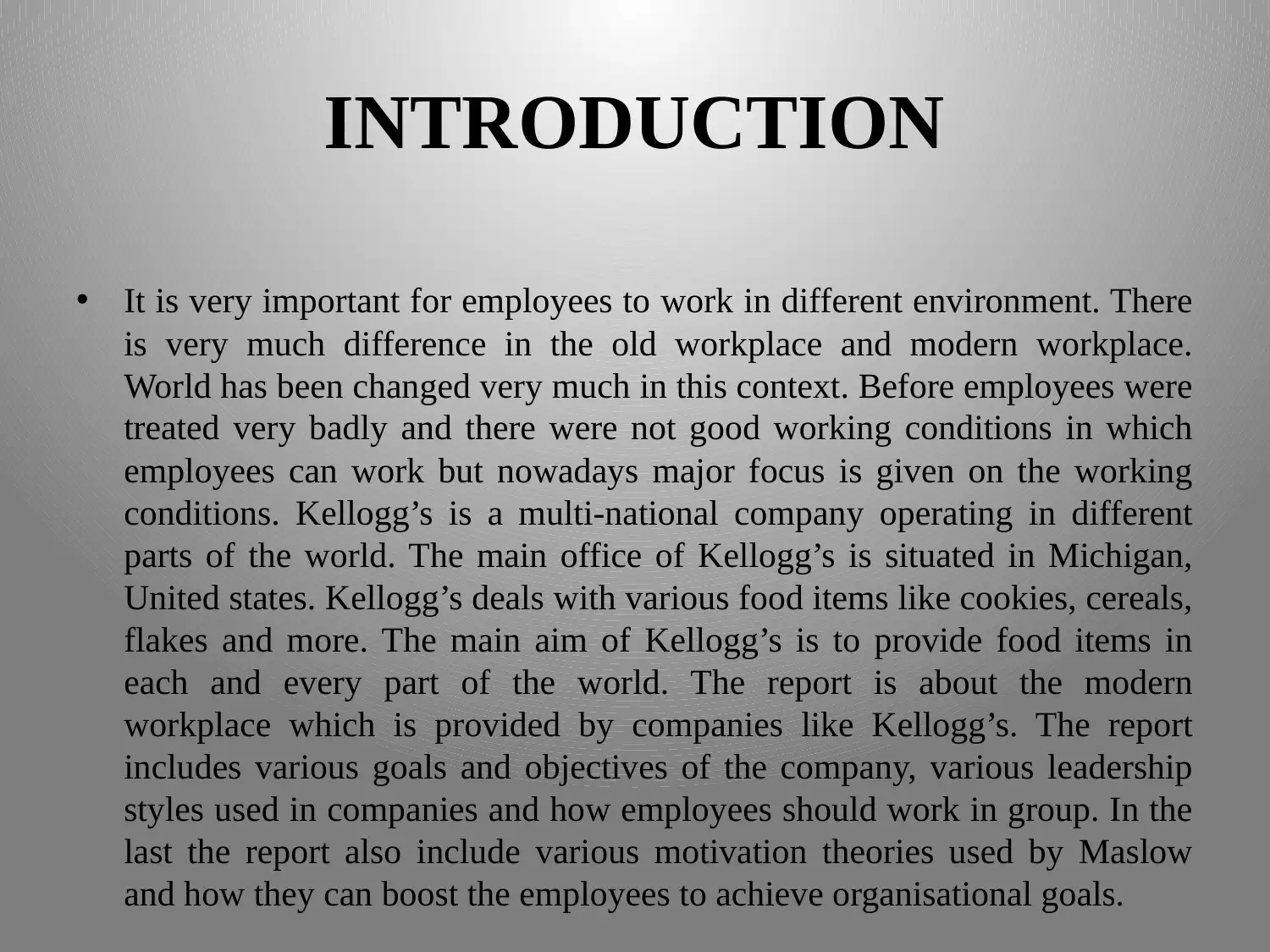
INTRODUCTION
• It is very important for employees to work in different environment. There
is very much difference in the old workplace and modern workplace.
World has been changed very much in this context. Before employees were
treated very badly and there were not good working conditions in which
employees can work but nowadays major focus is given on the working
conditions. Kellogg’s is a multi-national company operating in different
parts of the world. The main office of Kellogg’s is situated in Michigan,
United states. Kellogg’s deals with various food items like cookies, cereals,
flakes and more. The main aim of Kellogg’s is to provide food items in
each and every part of the world. The report is about the modern
workplace which is provided by companies like Kellogg’s. The report
includes various goals and objectives of the company, various leadership
styles used in companies and how employees should work in group. In the
last the report also include various motivation theories used by Maslow
and how they can boost the employees to achieve organisational goals.
• It is very important for employees to work in different environment. There
is very much difference in the old workplace and modern workplace.
World has been changed very much in this context. Before employees were
treated very badly and there were not good working conditions in which
employees can work but nowadays major focus is given on the working
conditions. Kellogg’s is a multi-national company operating in different
parts of the world. The main office of Kellogg’s is situated in Michigan,
United states. Kellogg’s deals with various food items like cookies, cereals,
flakes and more. The main aim of Kellogg’s is to provide food items in
each and every part of the world. The report is about the modern
workplace which is provided by companies like Kellogg’s. The report
includes various goals and objectives of the company, various leadership
styles used in companies and how employees should work in group. In the
last the report also include various motivation theories used by Maslow
and how they can boost the employees to achieve organisational goals.
⊘ This is a preview!⊘
Do you want full access?
Subscribe today to unlock all pages.

Trusted by 1+ million students worldwide
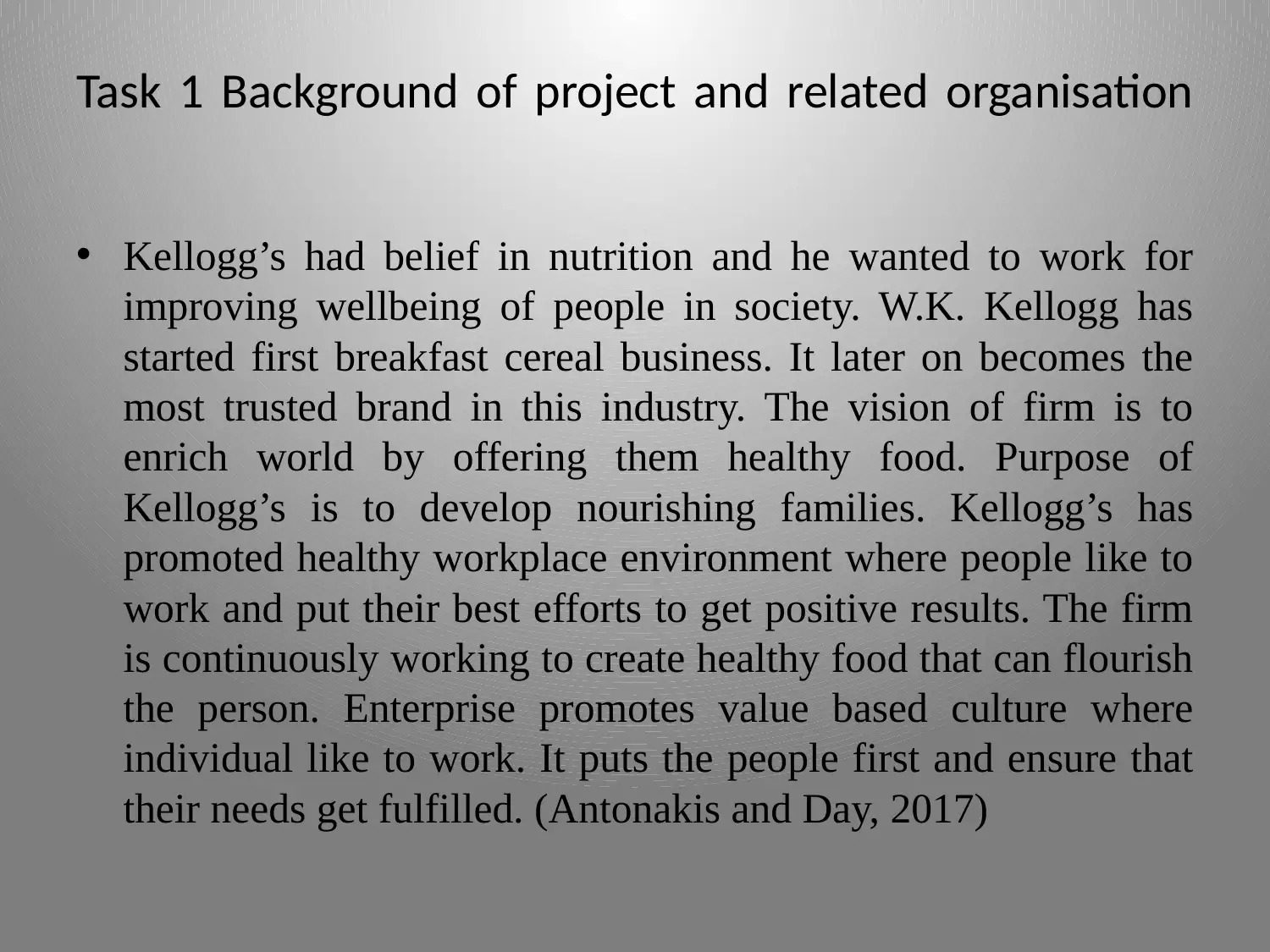
Task 1 Background of project and related organisation
• Kellogg’s had belief in nutrition and he wanted to work for
improving wellbeing of people in society. W.K. Kellogg has
started first breakfast cereal business. It later on becomes the
most trusted brand in this industry. The vision of firm is to
enrich world by offering them healthy food. Purpose of
Kellogg’s is to develop nourishing families. Kellogg’s has
promoted healthy workplace environment where people like to
work and put their best efforts to get positive results. The firm
is continuously working to create healthy food that can flourish
the person. Enterprise promotes value based culture where
individual like to work. It puts the people first and ensure that
their needs get fulfilled. (Antonakis and Day, 2017)
• Kellogg’s had belief in nutrition and he wanted to work for
improving wellbeing of people in society. W.K. Kellogg has
started first breakfast cereal business. It later on becomes the
most trusted brand in this industry. The vision of firm is to
enrich world by offering them healthy food. Purpose of
Kellogg’s is to develop nourishing families. Kellogg’s has
promoted healthy workplace environment where people like to
work and put their best efforts to get positive results. The firm
is continuously working to create healthy food that can flourish
the person. Enterprise promotes value based culture where
individual like to work. It puts the people first and ensure that
their needs get fulfilled. (Antonakis and Day, 2017)
Paraphrase This Document
Need a fresh take? Get an instant paraphrase of this document with our AI Paraphraser
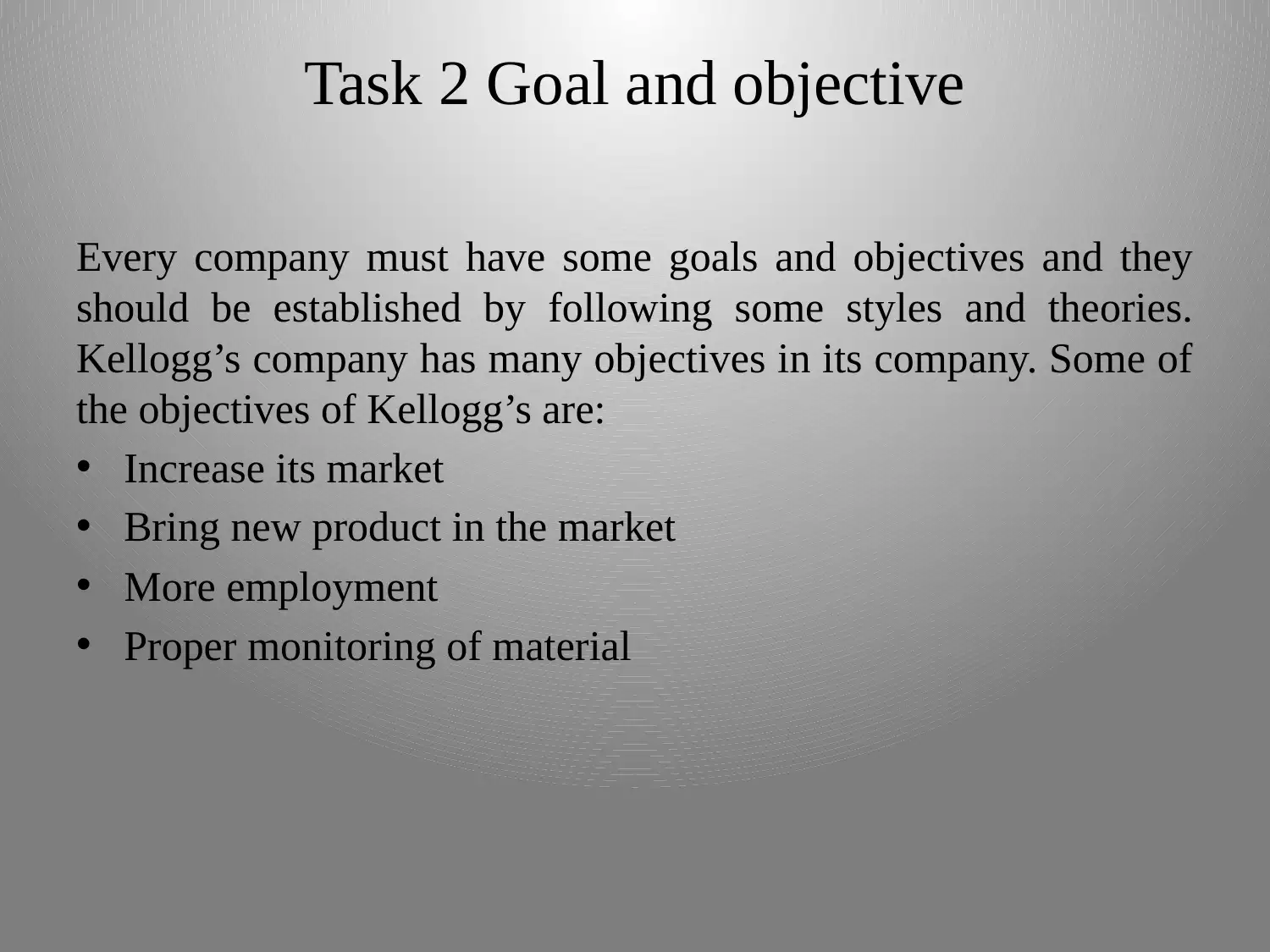
Task 2 Goal and objective
Every company must have some goals and objectives and they
should be established by following some styles and theories.
Kellogg’s company has many objectives in its company. Some of
the objectives of Kellogg’s are:
• Increase its market
• Bring new product in the market
• More employment
• Proper monitoring of material
Every company must have some goals and objectives and they
should be established by following some styles and theories.
Kellogg’s company has many objectives in its company. Some of
the objectives of Kellogg’s are:
• Increase its market
• Bring new product in the market
• More employment
• Proper monitoring of material
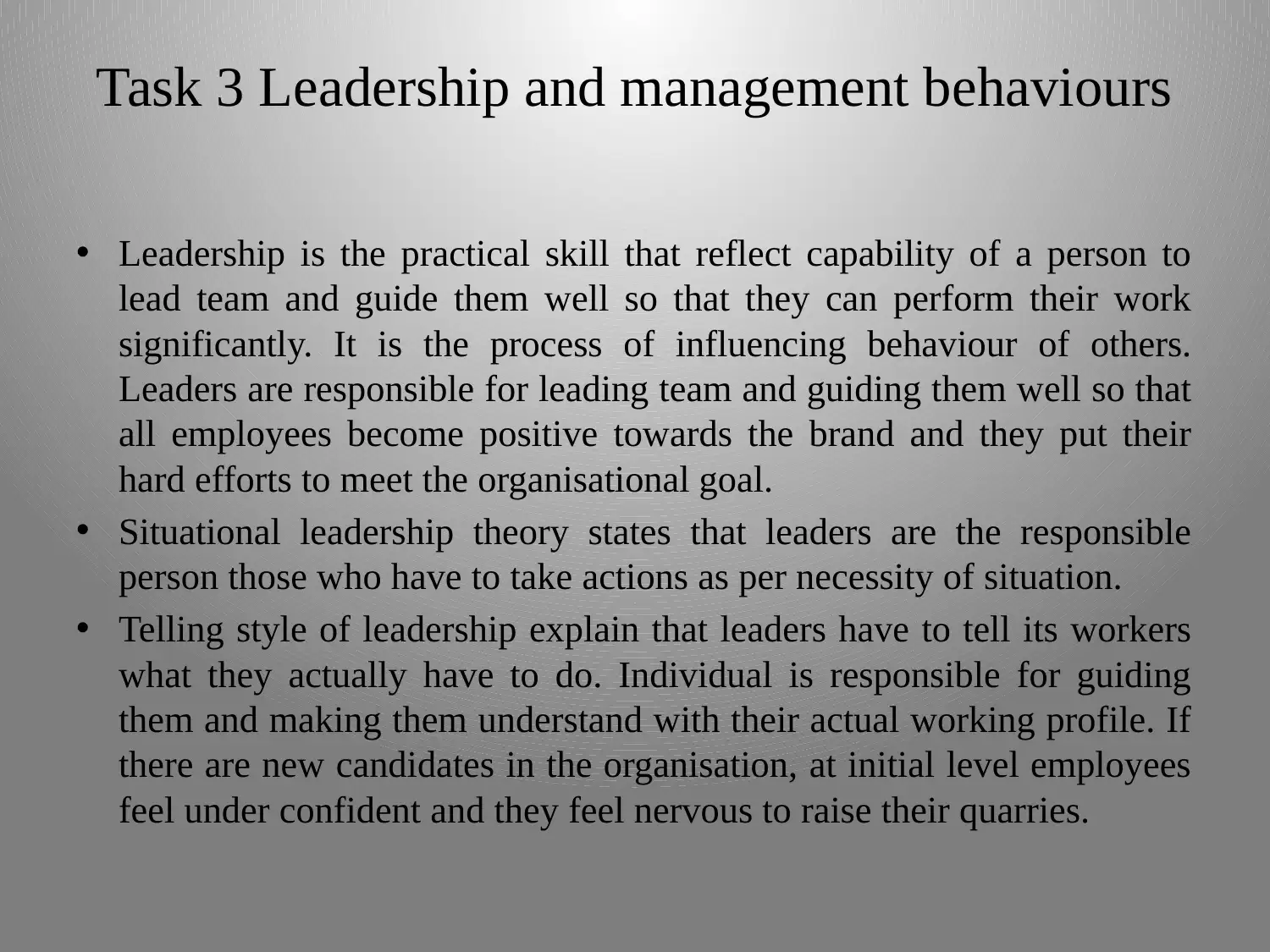
Task 3 Leadership and management behaviours
• Leadership is the practical skill that reflect capability of a person to
lead team and guide them well so that they can perform their work
significantly. It is the process of influencing behaviour of others.
Leaders are responsible for leading team and guiding them well so that
all employees become positive towards the brand and they put their
hard efforts to meet the organisational goal.
• Situational leadership theory states that leaders are the responsible
person those who have to take actions as per necessity of situation.
• Telling style of leadership explain that leaders have to tell its workers
what they actually have to do. Individual is responsible for guiding
them and making them understand with their actual working profile. If
there are new candidates in the organisation, at initial level employees
feel under confident and they feel nervous to raise their quarries.
• Leadership is the practical skill that reflect capability of a person to
lead team and guide them well so that they can perform their work
significantly. It is the process of influencing behaviour of others.
Leaders are responsible for leading team and guiding them well so that
all employees become positive towards the brand and they put their
hard efforts to meet the organisational goal.
• Situational leadership theory states that leaders are the responsible
person those who have to take actions as per necessity of situation.
• Telling style of leadership explain that leaders have to tell its workers
what they actually have to do. Individual is responsible for guiding
them and making them understand with their actual working profile. If
there are new candidates in the organisation, at initial level employees
feel under confident and they feel nervous to raise their quarries.
⊘ This is a preview!⊘
Do you want full access?
Subscribe today to unlock all pages.

Trusted by 1+ million students worldwide
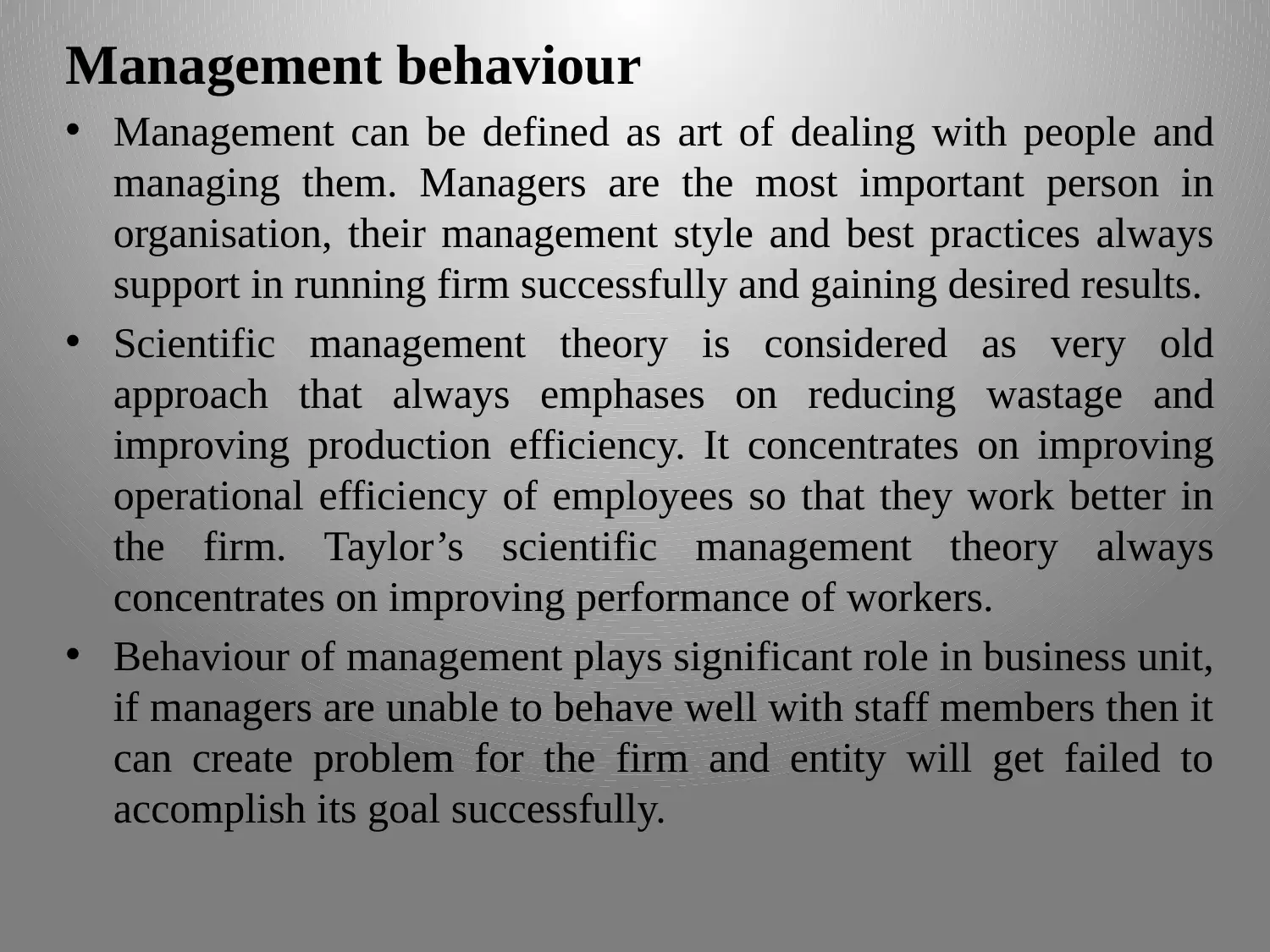
Management behaviour
• Management can be defined as art of dealing with people and
managing them. Managers are the most important person in
organisation, their management style and best practices always
support in running firm successfully and gaining desired results.
• Scientific management theory is considered as very old
approach that always emphases on reducing wastage and
improving production efficiency. It concentrates on improving
operational efficiency of employees so that they work better in
the firm. Taylor’s scientific management theory always
concentrates on improving performance of workers.
• Behaviour of management plays significant role in business unit,
if managers are unable to behave well with staff members then it
can create problem for the firm and entity will get failed to
accomplish its goal successfully.
• Management can be defined as art of dealing with people and
managing them. Managers are the most important person in
organisation, their management style and best practices always
support in running firm successfully and gaining desired results.
• Scientific management theory is considered as very old
approach that always emphases on reducing wastage and
improving production efficiency. It concentrates on improving
operational efficiency of employees so that they work better in
the firm. Taylor’s scientific management theory always
concentrates on improving performance of workers.
• Behaviour of management plays significant role in business unit,
if managers are unable to behave well with staff members then it
can create problem for the firm and entity will get failed to
accomplish its goal successfully.
Paraphrase This Document
Need a fresh take? Get an instant paraphrase of this document with our AI Paraphraser
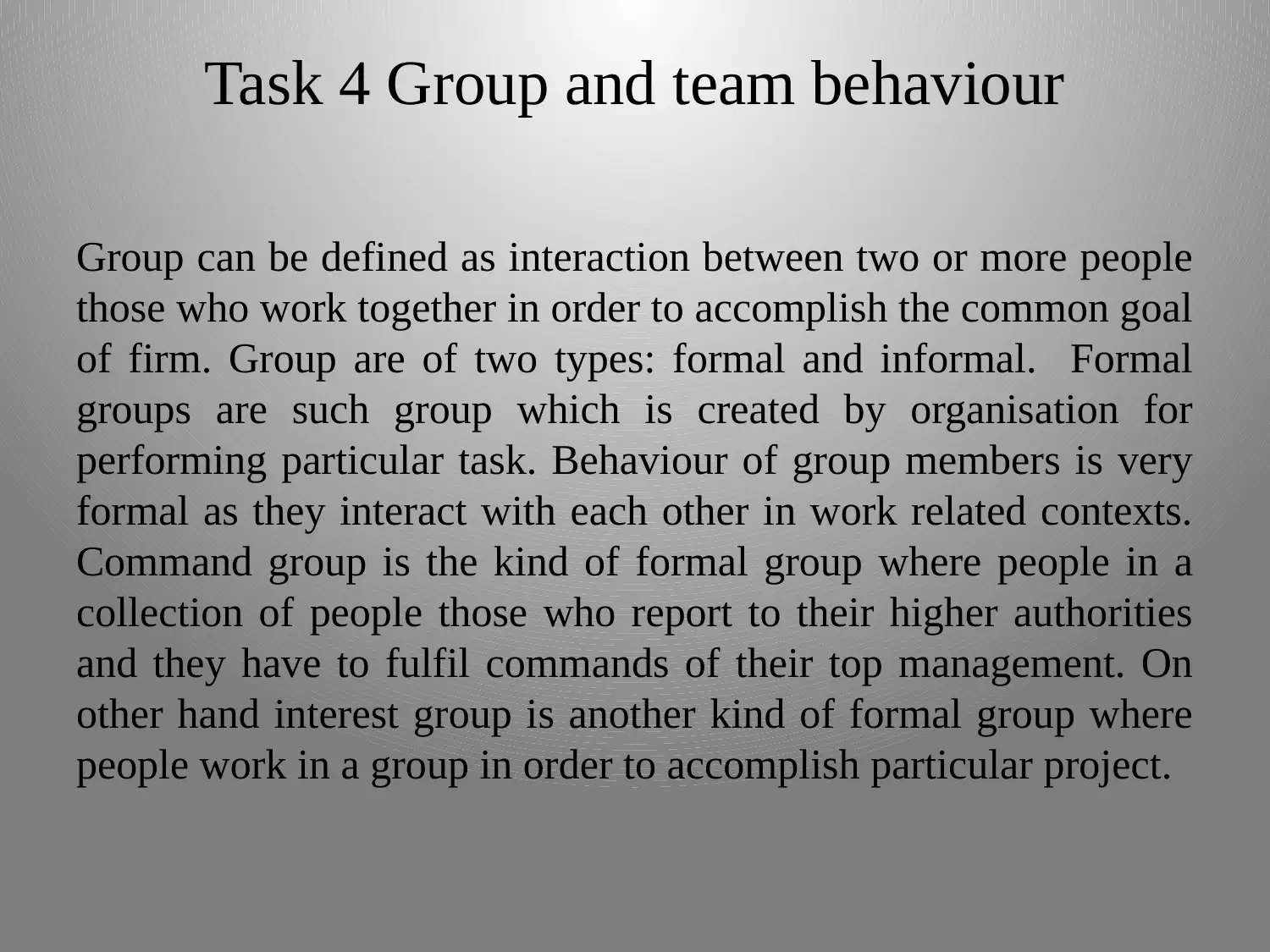
Task 4 Group and team behaviour
Group can be defined as interaction between two or more people
those who work together in order to accomplish the common goal
of firm. Group are of two types: formal and informal. Formal
groups are such group which is created by organisation for
performing particular task. Behaviour of group members is very
formal as they interact with each other in work related contexts.
Command group is the kind of formal group where people in a
collection of people those who report to their higher authorities
and they have to fulfil commands of their top management. On
other hand interest group is another kind of formal group where
people work in a group in order to accomplish particular project.
Group can be defined as interaction between two or more people
those who work together in order to accomplish the common goal
of firm. Group are of two types: formal and informal. Formal
groups are such group which is created by organisation for
performing particular task. Behaviour of group members is very
formal as they interact with each other in work related contexts.
Command group is the kind of formal group where people in a
collection of people those who report to their higher authorities
and they have to fulfil commands of their top management. On
other hand interest group is another kind of formal group where
people work in a group in order to accomplish particular project.
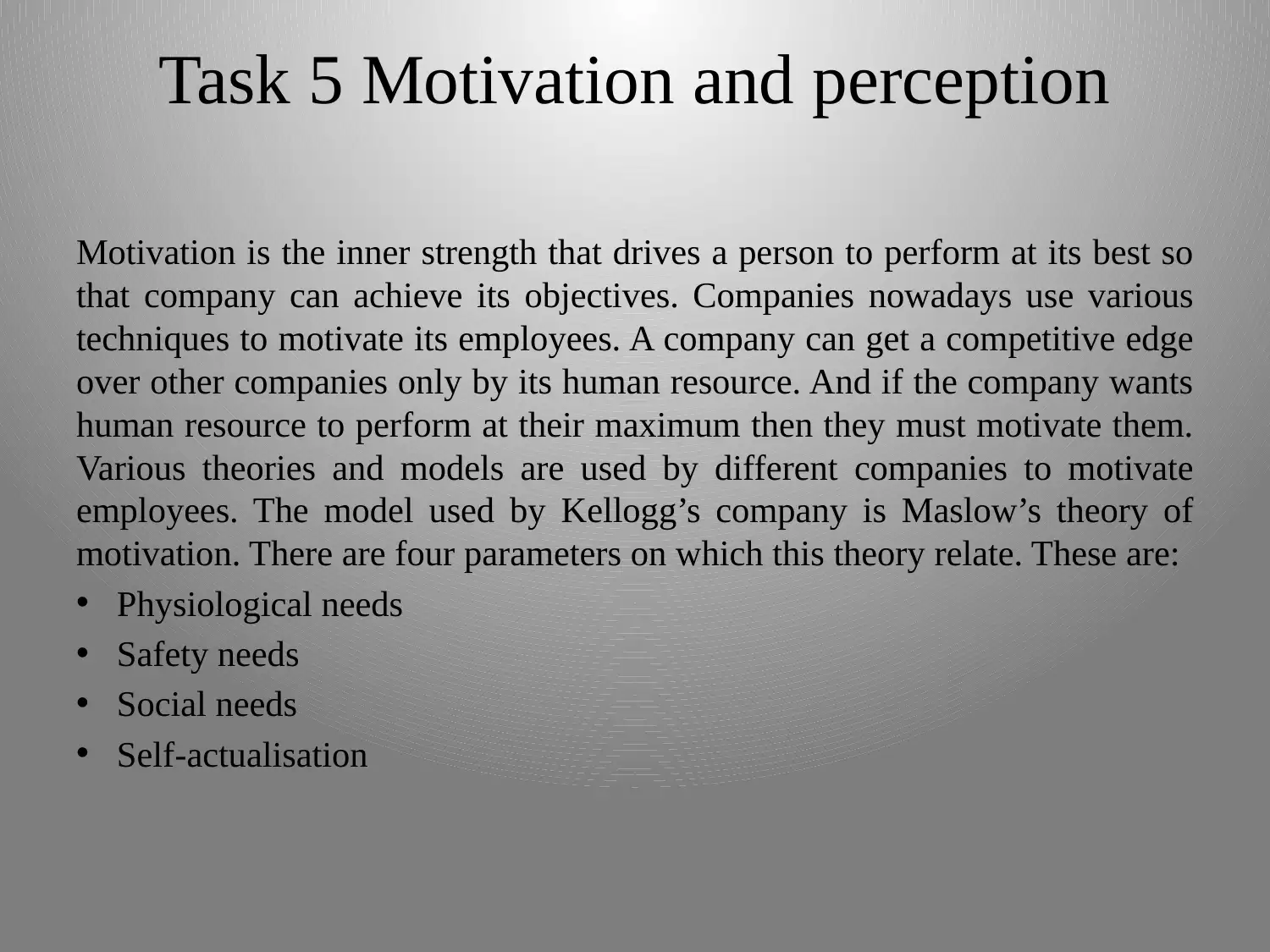
Task 5 Motivation and perception
Motivation is the inner strength that drives a person to perform at its best so
that company can achieve its objectives. Companies nowadays use various
techniques to motivate its employees. A company can get a competitive edge
over other companies only by its human resource. And if the company wants
human resource to perform at their maximum then they must motivate them.
Various theories and models are used by different companies to motivate
employees. The model used by Kellogg’s company is Maslow’s theory of
motivation. There are four parameters on which this theory relate. These are:
• Physiological needs
• Safety needs
• Social needs
• Self-actualisation
Motivation is the inner strength that drives a person to perform at its best so
that company can achieve its objectives. Companies nowadays use various
techniques to motivate its employees. A company can get a competitive edge
over other companies only by its human resource. And if the company wants
human resource to perform at their maximum then they must motivate them.
Various theories and models are used by different companies to motivate
employees. The model used by Kellogg’s company is Maslow’s theory of
motivation. There are four parameters on which this theory relate. These are:
• Physiological needs
• Safety needs
• Social needs
• Self-actualisation
⊘ This is a preview!⊘
Do you want full access?
Subscribe today to unlock all pages.

Trusted by 1+ million students worldwide
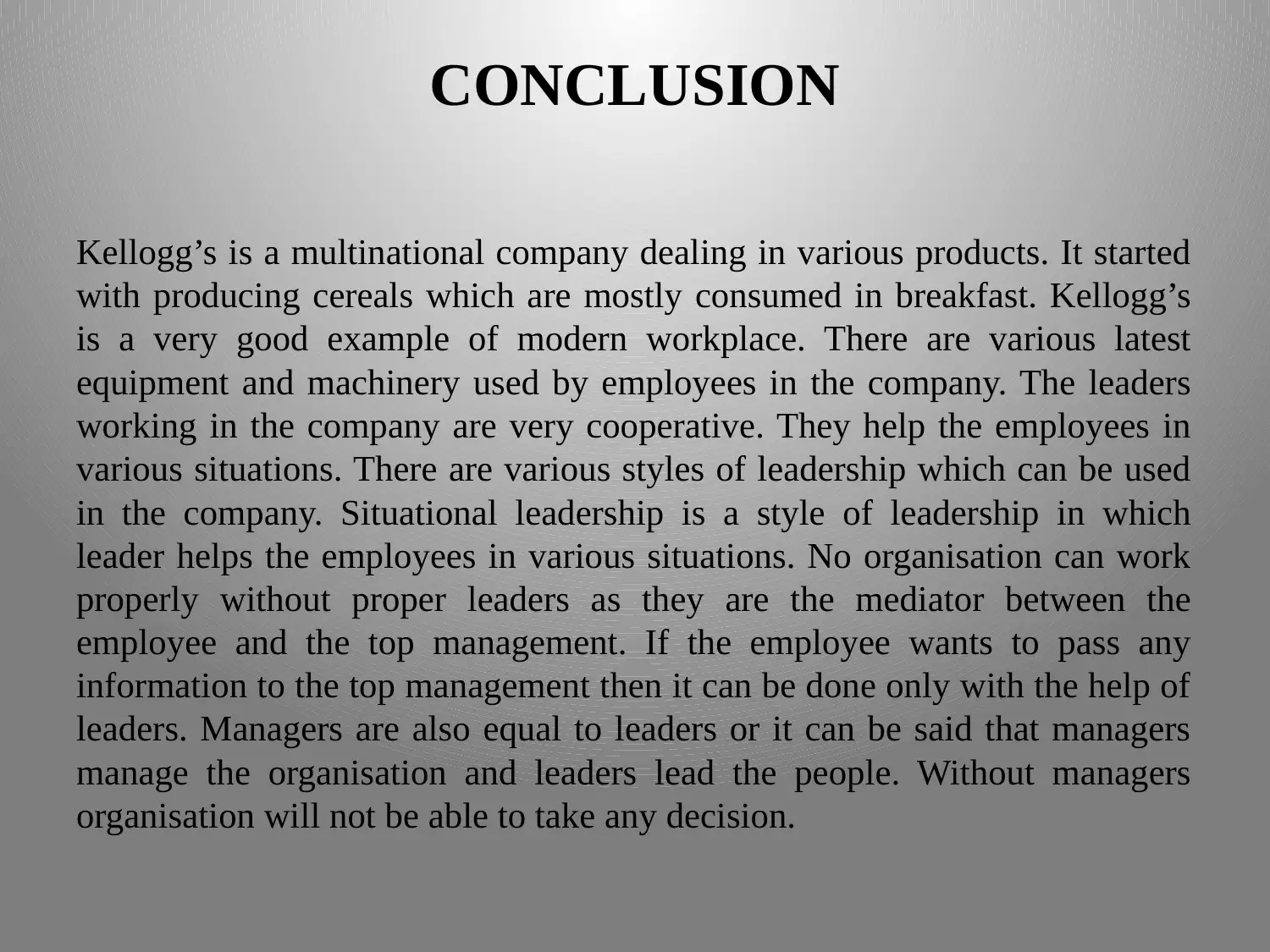
CONCLUSION
Kellogg’s is a multinational company dealing in various products. It started
with producing cereals which are mostly consumed in breakfast. Kellogg’s
is a very good example of modern workplace. There are various latest
equipment and machinery used by employees in the company. The leaders
working in the company are very cooperative. They help the employees in
various situations. There are various styles of leadership which can be used
in the company. Situational leadership is a style of leadership in which
leader helps the employees in various situations. No organisation can work
properly without proper leaders as they are the mediator between the
employee and the top management. If the employee wants to pass any
information to the top management then it can be done only with the help of
leaders. Managers are also equal to leaders or it can be said that managers
manage the organisation and leaders lead the people. Without managers
organisation will not be able to take any decision.
Kellogg’s is a multinational company dealing in various products. It started
with producing cereals which are mostly consumed in breakfast. Kellogg’s
is a very good example of modern workplace. There are various latest
equipment and machinery used by employees in the company. The leaders
working in the company are very cooperative. They help the employees in
various situations. There are various styles of leadership which can be used
in the company. Situational leadership is a style of leadership in which
leader helps the employees in various situations. No organisation can work
properly without proper leaders as they are the mediator between the
employee and the top management. If the employee wants to pass any
information to the top management then it can be done only with the help of
leaders. Managers are also equal to leaders or it can be said that managers
manage the organisation and leaders lead the people. Without managers
organisation will not be able to take any decision.
Paraphrase This Document
Need a fresh take? Get an instant paraphrase of this document with our AI Paraphraser
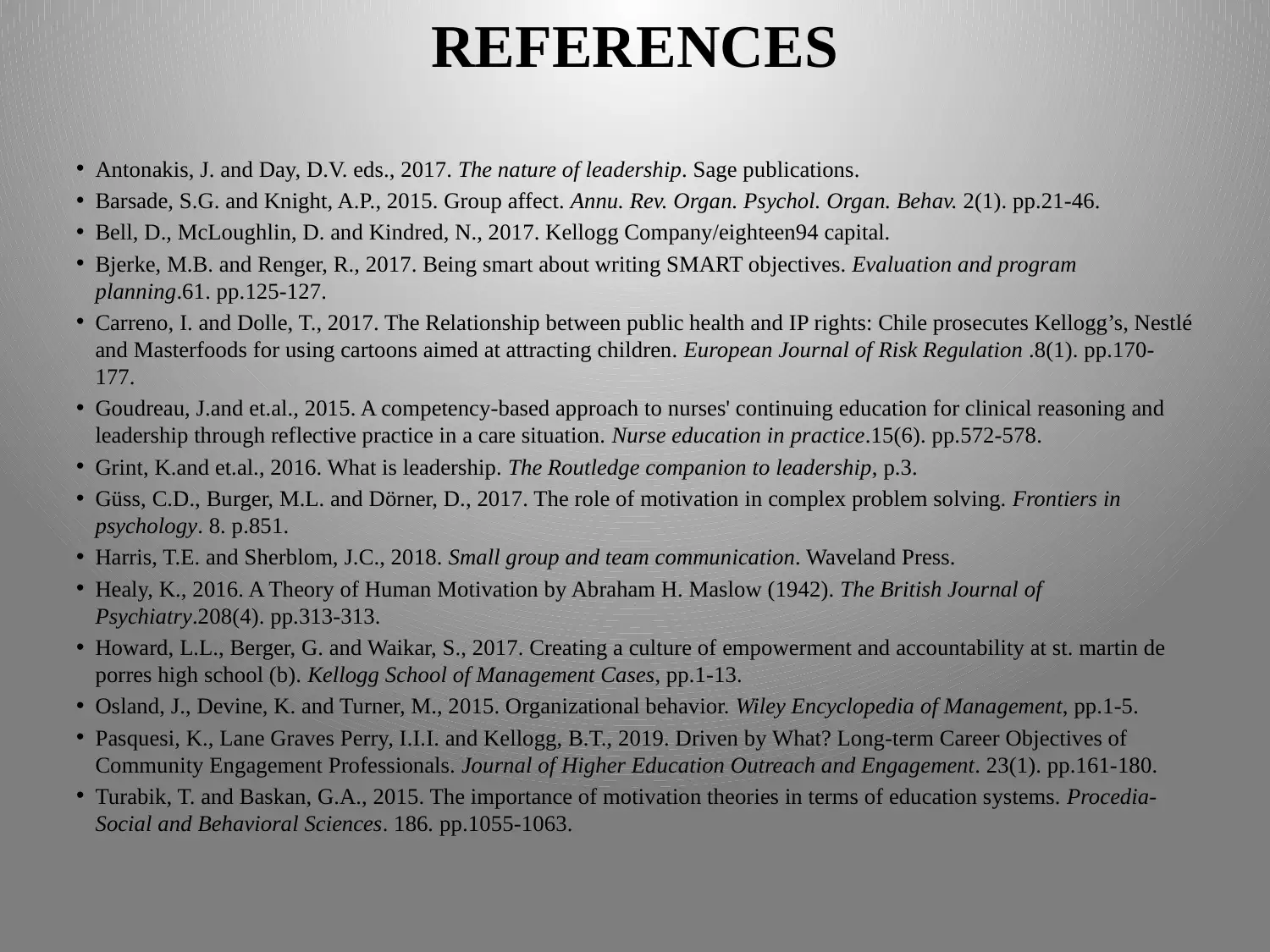
REFERENCES
• Antonakis, J. and Day, D.V. eds., 2017. The nature of leadership. Sage publications.
• Barsade, S.G. and Knight, A.P., 2015. Group affect. Annu. Rev. Organ. Psychol. Organ. Behav. 2(1). pp.21-46.
• Bell, D., McLoughlin, D. and Kindred, N., 2017. Kellogg Company/eighteen94 capital.
• Bjerke, M.B. and Renger, R., 2017. Being smart about writing SMART objectives. Evaluation and program
planning.61. pp.125-127.
• Carreno, I. and Dolle, T., 2017. The Relationship between public health and IP rights: Chile prosecutes Kellogg’s, Nestlé
and Masterfoods for using cartoons aimed at attracting children. European Journal of Risk Regulation .8(1). pp.170-
177.
• Goudreau, J.and et.al., 2015. A competency-based approach to nurses' continuing education for clinical reasoning and
leadership through reflective practice in a care situation. Nurse education in practice.15(6). pp.572-578.
• Grint, K.and et.al., 2016. What is leadership. The Routledge companion to leadership, p.3.
• Güss, C.D., Burger, M.L. and Dörner, D., 2017. The role of motivation in complex problem solving. Frontiers in
psychology. 8. p.851.
• Harris, T.E. and Sherblom, J.C., 2018. Small group and team communication. Waveland Press.
• Healy, K., 2016. A Theory of Human Motivation by Abraham H. Maslow (1942). The British Journal of
Psychiatry.208(4). pp.313-313.
• Howard, L.L., Berger, G. and Waikar, S., 2017. Creating a culture of empowerment and accountability at st. martin de
porres high school (b). Kellogg School of Management Cases, pp.1-13.
• Osland, J., Devine, K. and Turner, M., 2015. Organizational behavior. Wiley Encyclopedia of Management, pp.1-5.
• Pasquesi, K., Lane Graves Perry, I.I.I. and Kellogg, B.T., 2019. Driven by What? Long-term Career Objectives of
Community Engagement Professionals. Journal of Higher Education Outreach and Engagement. 23(1). pp.161-180.
• Turabik, T. and Baskan, G.A., 2015. The importance of motivation theories in terms of education systems. Procedia-
Social and Behavioral Sciences. 186. pp.1055-1063.
• Antonakis, J. and Day, D.V. eds., 2017. The nature of leadership. Sage publications.
• Barsade, S.G. and Knight, A.P., 2015. Group affect. Annu. Rev. Organ. Psychol. Organ. Behav. 2(1). pp.21-46.
• Bell, D., McLoughlin, D. and Kindred, N., 2017. Kellogg Company/eighteen94 capital.
• Bjerke, M.B. and Renger, R., 2017. Being smart about writing SMART objectives. Evaluation and program
planning.61. pp.125-127.
• Carreno, I. and Dolle, T., 2017. The Relationship between public health and IP rights: Chile prosecutes Kellogg’s, Nestlé
and Masterfoods for using cartoons aimed at attracting children. European Journal of Risk Regulation .8(1). pp.170-
177.
• Goudreau, J.and et.al., 2015. A competency-based approach to nurses' continuing education for clinical reasoning and
leadership through reflective practice in a care situation. Nurse education in practice.15(6). pp.572-578.
• Grint, K.and et.al., 2016. What is leadership. The Routledge companion to leadership, p.3.
• Güss, C.D., Burger, M.L. and Dörner, D., 2017. The role of motivation in complex problem solving. Frontiers in
psychology. 8. p.851.
• Harris, T.E. and Sherblom, J.C., 2018. Small group and team communication. Waveland Press.
• Healy, K., 2016. A Theory of Human Motivation by Abraham H. Maslow (1942). The British Journal of
Psychiatry.208(4). pp.313-313.
• Howard, L.L., Berger, G. and Waikar, S., 2017. Creating a culture of empowerment and accountability at st. martin de
porres high school (b). Kellogg School of Management Cases, pp.1-13.
• Osland, J., Devine, K. and Turner, M., 2015. Organizational behavior. Wiley Encyclopedia of Management, pp.1-5.
• Pasquesi, K., Lane Graves Perry, I.I.I. and Kellogg, B.T., 2019. Driven by What? Long-term Career Objectives of
Community Engagement Professionals. Journal of Higher Education Outreach and Engagement. 23(1). pp.161-180.
• Turabik, T. and Baskan, G.A., 2015. The importance of motivation theories in terms of education systems. Procedia-
Social and Behavioral Sciences. 186. pp.1055-1063.

⊘ This is a preview!⊘
Do you want full access?
Subscribe today to unlock all pages.

Trusted by 1+ million students worldwide
1 out of 12
Related Documents
Your All-in-One AI-Powered Toolkit for Academic Success.
+13062052269
info@desklib.com
Available 24*7 on WhatsApp / Email
![[object Object]](/_next/static/media/star-bottom.7253800d.svg)
Unlock your academic potential
Copyright © 2020–2025 A2Z Services. All Rights Reserved. Developed and managed by ZUCOL.





